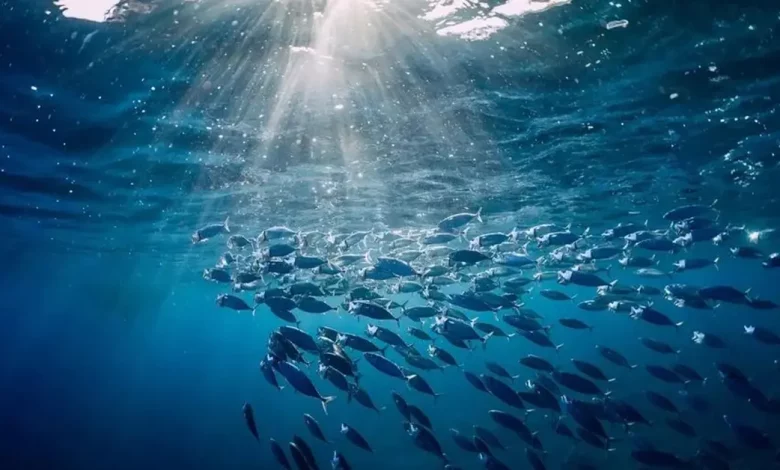
Context- The Interim Budget presented by the Finance Minister stressed on environment-friendly development through the promotion of ‘blue economy’.
About
- The finances proposes to sell climate resilient activities for blue economic system 2.0 for recovery and edition measures.
- Additionally, the finances outlines plans to set up 5 included aqua parks and beautify the Pradhan Mantri Matsya Sampada Yojana (PMMSY) to increase aquaculture productiveness, double exports, and generate employment opportunities.
Blue Economy
- The World Bank says the blue economic system is the “sustainable use of ocean resources for economic growth, improved livelihoods, and jobs while preserving the health of the ocean ecosystem.”
- Pillars: Fisheries, aquaculture, maritime shipping, renewable electricity from the sea, coastal tourism, and marine biotechnology.
Blue economic system 1.0 vs 2.0
- The idea of Blue Economy 2.0 is still evolving, however India’s “Blue Economy 2.0” makes a speciality of precise areas like coastal recuperation, aquaculture improvement, and climate-resilient activities in the broader framework of sustainable ocean management.
Significance
- Huge coastline: India with a 7,517-kilometre-long coastline, with nine coastal states and 1,382 islands the blue economy is highly significant.
- On major sea strains of exchange: There are nearly 199 ports, which include 12 major ports that take care of approximately 1,400 million lots of cargo every year.
- Large EEZ: India’s Exclusive Economic Zone(EEZ) of over 2 million square kilometers has a bounty of living and non-residing assets with extensive recoverable resources which include crude oil and natural gas.
- Livelihood: The coastal economy sustains over four million fishermen and coastal communities.
- Economic and Trade Potential: The Indian Ocean Region is considerable with resources, especially in the sectors of fisheries, aquaculture, ocean strength, sea-bed mining and minerals, and gives high-quality economic possibilities to increase marine tourism and shipping activities.
- Natural resources: Polymetallic nodules and polymetallic massive sulfides are the two mineral sources of commercial interest to developers in the Indian Ocean.
Challenges
- Environmental Challenges:
-
-
- Overexploitation of resources: Unsustainable fishing practices, pollution, and habitat destruction threaten marine biodiversity and ecosystem health.
- Climate exchange: Rising sea levels, ocean acidification, and severe weather events disrupt coastal communities and marine ecosystems.
- Pollution: Untreated sewage, commercial waste, and plastic pollution contaminate coastal waters, impacting human health and marine life.
-
- Economic Challenges:
-
-
- Lack of infrastructure: Inadequate port centers, cold garage, and transportation networks restrict efficient utilization of marine assets.
- Limited funding: Insufficient funding for research, innovation, and development of sustainable technology hampers growth.
- Skill hole: Lack of professional professionals in areas like marine engineering, aquaculture, and ocean governance hinders development.
-
- Social Challenges:
-
-
- Livelihood dependence: Traditional fishing communities face demanding situations due to resource depletion and competition from large-scale fishing.
- Coastal erosion and displacement: Rising sea degrees and intense weather events displace coastal groups and disrupt livelihoods.
- Equity and get entry to: Equitable distribution of benefits from the Blue Economy stays a subject, especially for marginalized communities.
-
- Governance Challenges:
-
- Policy and regulation: Ineffective guidelines and enforcement avert sustainable practices and prevent unlawful sports like large-scale fishing.
- Institutional coordination: Lack of coordination among different government agencies accountable for coping with marine resources creates hurdles.
Measures
- Sustainable practices: Implementing measures like quotas, closed seasons, and marine protected regions to make sure sustainable useful resource utilization.
- Technological innovation: Investing in R&D for technology like aquaculture, renewable ocean energy, and pollution control.
- Skilling and ability constructing: Training applications to equip coastal communities with applicable abilities for destiny Blue Economy jobs.
- Community engagement: Engaging nearby groups in decision-making strategies and ensuring equitable distribution of benefits.
- Strengthened governance: Robust guidelines, effective enforcement, and progressed coordination among government agencies.
- International collaboration: Engaging in local and worldwide tasks to address shared challenges and promote sustainable ocean management.
Government steps
- Draft coverage on India’s Blue Economy, 2022: Recommended on National Accounting Framework for Blue Economy and Ocean Governance, Coastal Marine Spatial Planning and Tourism Priority, Marine Fisheries, Aquaculture and amongst others.
- Integrated Coastal Zone Management (ICZM) Program: Aims to balance economic improvement with environmental safety and conservation in coastal regions.
- Sagarmala Project: Focuses on port modernization, coastal infrastructure improvement, and maritime connectivity to improve logistics and alternate.
- Deep Ocean Mission: Promotes studies and exploration of the deep sea for sustainable usage of resources and clinical advancement.
- Indian Ocean Rim Association (IORA): Collaborates with regional countries on Blue Economy tasks like sustainable fisheries control and marine pollutants control.
- The Interim Budget 2024-25 document refers to blue economic system 2.0 and announced the putting in place of five incorporated aqua parks.
- Two priorities for the Supreme Audit Institutions 20 (SAI20) deliberations during the G20 meet were blue economy and responsible Artificial Intelligence.
Way Ahead
- With significant maritime pursuits, the blue economy occupies a critical capacity function in India’s economic increase.
- It may want to properly be the subsequent multiplier of GDP and well-being, provided sustainability and socio-economic welfare are saved center-level.
- Transitioning from 1.0 to 2.0 requires collaborative efforts from governments, businesses, research institutions, and communities to develop and implement sustainable practices.
Source: Indian Express





.png)



